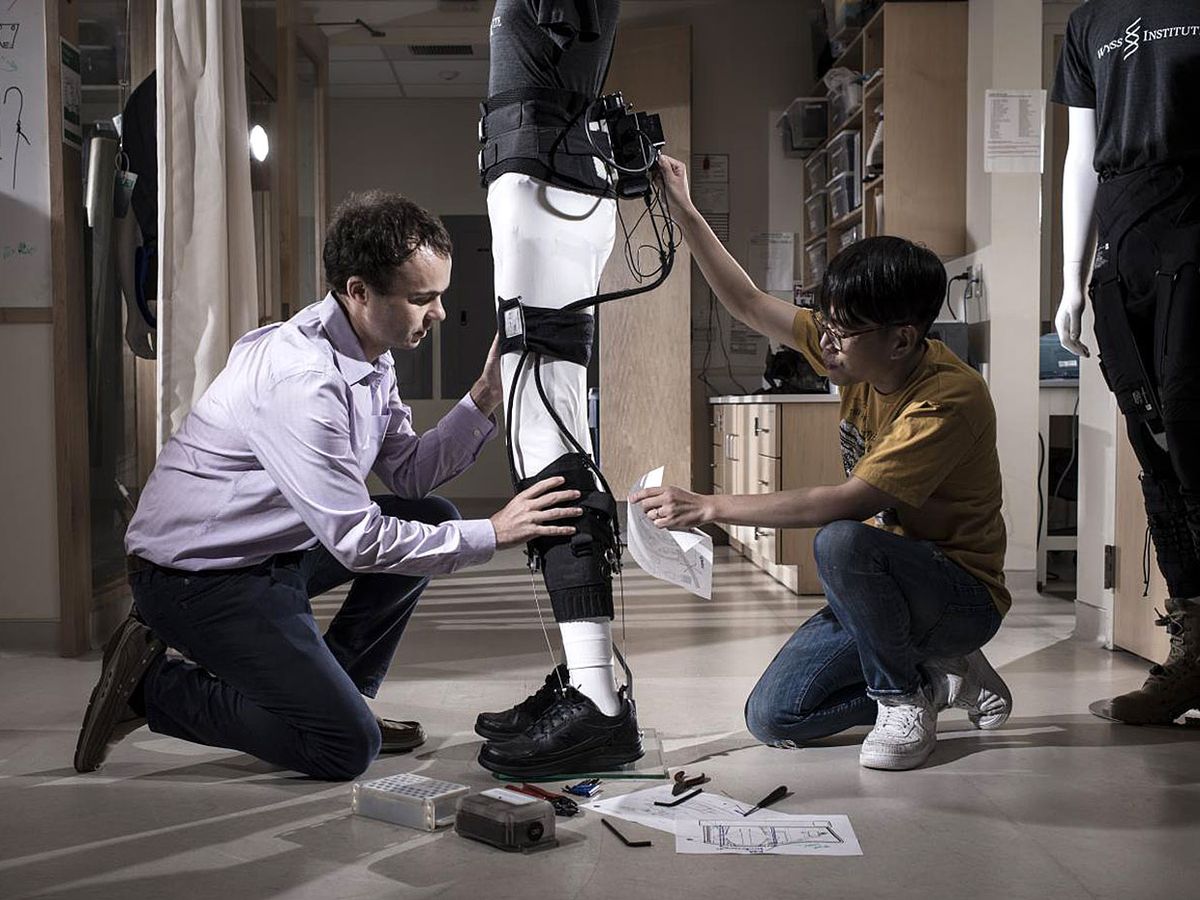Video: Rolex Awards for Enterprise
What began as a program for the U.S. Defense Advanced Research Projects Agencyto help soldiers carry heavy packs with less effort led IEEE Member Conor Walsh and his group at Harvard to design a lightweight exosuit for stroke patients and those with weakened leg joints.
Walsh, an associate professor at Harvard’s John A. Paulson School of Engineering and Applied Sciences, also teaches at the university’s Wyss Institute for Biologically Inspired Engineering. And he founded Harvard’s Biodesign Lab, which brings together researchers from different disciplines.
The exosuit is a wearable robot made of soft, lightweight textiles, with cables and motors that target leg joints, training the patient to walk normally.

Walsh recently was honored for his work on the exosuit. He received the 2017 IEEE Robotics and Automation Society Early Career Award. Walsh, who is 35, was cited “for contributions to soft robotics and wearable technology for rehabilitation.”
He is coauthor of “Multi-Joint Soft Exosuit for Gait Assistance,” published in the proceedings of the 2015 IEEE International Conference on Robotics and Automation, available in the IEEE Xplore Digital Library.
The Institute interviewed him about the exosuit and his efforts to encourage students to get involved in wearable robotics.
What inspired you to design a wearable robot?
I worked on rigid exoskeletons as a graduate student at MIT with Professor Hugh Herr, an IEEE member, and learned a lot about robotics and human locomotion. After having his legs amputated due to frostbite, Herr, an associate professor of biomechatronics, developed prosthetic feet.
MIT is where I also first learned about the challenges of adding extra weight to a person and aligning human joints with an exoskeleton’s joints.
How did the soft exosuit come about?
Starting at Harvard in 2012, I was inspired by colleagues working with silicone, plastic, and soft materials to make soft robotics. We began developing the exosuit with the goal of helping healthy people walk with less effort.
In 2014 we started exploring the possibility of adapting the technology for stroke patients. A stroke can impact gait when it causes the person to drag the affected leg. The soft exosuit can help propel the wearer forward; it lifts his feet and keeps his toes from turning down so that they don’t drag on the ground and cause him to stumble. The concept was first presented at the 2015 IEEE International Conference on Rehabilitation Robotics.
How does the exosuit work?
The soft exosuit transmits assistive torques to the wearer’s ankle joints without relying on rigid external structures. Motors, pulleys, and a battery pack are carried in a waist belt. The suit also has a wrap for each calf, four vertical straps (two per leg), sensors, and cables. The cables are attached to the material near each ankle joint; motors pull on the cables to help support the wearer’s movement. Some of this force is also transmitted through the vertical straps to the front of the waist belt to help with hip gait motion.
When the wearer lifts a foot to take a step, he pulls on the cables, which helps lift the wearer’s leg. Then, as the foot swings forward, another cable, attached to the toe cap of the shoe, tightens to help raise the toe so that it does not drag on the ground.
The sensors monitor the person’s movement. That information is analyzed by a microprocessor, worn on the belt, which determines when to send power to the motors. This enables the suit to deliver assistance exactly when help is needed to take a step, lift a foot, push off the ground, or place the foot down. The soft exosuit also adjusts to match a healthy person’s gait.
Are you working with anyone to manufacture your exosuit?
Last year, we partnered with ReWalk Robotics of Marlborough, Mass., and we’re collaborating to bring the technology to those who can benefit from it.
What led you to found the Harvard Biodesign Lab, and what other projects are in the works?
The lab develops fundamentally disruptive approaches around technologies related to wearable soft robotics. This requires a multidisciplinary team that includes researchers in robotics, apparel design, human biomechanics, and physical therapy. We perform medical and market research in different application areas to understand the problems and opportunities, and identify advances needed to address unmet needs.
Current projects include inflatable soft robotics for upper-extremity applications, and braces to help prevent injury and promote recovery. We are also developing educational materials to train future innovators in engineering design and soft robotics.
What about the Harvard Medical Device Innovation Initiative and Soft Robotics Toolkit you helped establish?
The medical initiative spun out of the Harvard Biodesign Lab. Launched in 2011, the initiative develops educational programs that train the next generation of innovators, giving them hands-on experience in developing cutting-edge medical devices and instruments for real-world problems. The initiative includes lectures, courses, and a summer program.
We are also developing educational materials to be used at soft robotics workshops and competitions in high schools. The Soft Robotics Toolkit, spun out of the Harvard Biodesign Lab, supports the design, fabrication, modeling, characterization, and control of soft robotic devices. We hope the toolkit will advance the field of soft robotics by allowing designers and researchers to build upon each other’s work. It includes an open-source fluidics control board, design documentation describing a wide variety of soft robotic components including actuators and sensors, and downloadable files used to design, manufacture, and operate soft robots.
